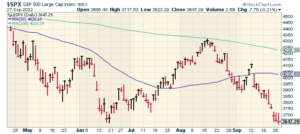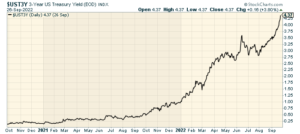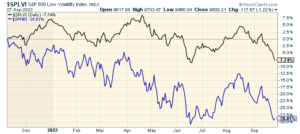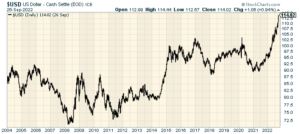CWS Market Review – September 27, 2022
(This is the free version of CWS Market Review. If you like what you see, then please sign up for the premium newsletter for $20 per month or $200 for the whole year. If you sign up today, you can see our two reports, “Your Handy Guide to Stock Orders” and “How Not to Get Screwed on Your Mortgage.”)
The Stock Market Plunges to a 21-Month Low
Alas, the bear market is still with us. The S&P 500 fell on Tuesday for the sixth day in a row. Four of those times, the market lost more than 1%. In the last 11 sessions, the market has lost more than 11%. Yuck!
The S&P 500 finished Tuesday at its lowest level since December 14, 2020. Today was actually the market’s best day of the last six with a loss of only 0.21%. The S&P 500 has now traded below its 200-day moving average for over 110 days in a row. That’s one of the longest such streaks in the last 15 years.

During the summer, the stock market staged an impressive rally. The S&P 500 gained more than 17% in two months. Was the bear market finally over? Frankly, I was skeptical. Bear-market rallies exist to lure us back in and convince us that things are safe, only to then slam the door on us. Well, that’s exactly what happened.
In just six weeks, we gave the entire summer rally back. Not only did the S&P 500 break below its June low but the Dow Jones dropped below its pre-Covid high from 31 months ago—and I’m not adjusting for the impact of inflation, which is running at close to 14% over the last two years.
Earlier today, the S&P 500 dropped below its intra-day low from June 17. Previously, that had been the low point of the bear market, until today. This has been a terrible year for stocks.
It’s not some giant mystery what’s going on. The issues that first spooked the market are still with us. The last inflation report was surprisingly high. Core inflation doubled expectations. We also know that the Federal Reserve is committed to raising interest rates to fight inflation.
Last week, the Fed hiked interest rates by 0.75%. That was its third 75-point hike in the last three meetings. According to the futures market, we should expect a fourth 0.75% hike in November, just a few days before the mid-term elections. The futures market sees the Fed funds target range getting to a high of 4.50% to 4.75% in less than six months from now. That’s what’s hanging over the entire market.
To give you an idea of how much things have changed, two years ago, the yield on the three-year Treasury was going for 0.1%. Today, the yield hit 4.39%. In fact, the one-year yield had previously been the highest-yielding Treasury. The highest-yield crown has been passed to the three-year Treasury. In simple terms, that means the market sees interest rates staying higher for longer. I think the market is right on that.

This gets to the heart of what interest rates do to stocks. Higher interest rates are like kryptonite to the stock market. It’s a double whammy effect. For one thing, it cuts into profits because it raises borrowing costs. That makes it more expensive to fund operations or expansion plans. Higher rates also make it more difficult for consumers to buy large-ticket items like houses or cars. The average adjustable-rate mortgage payment has rocketed higher over the last year.
The Q3 earnings season will start in about two weeks. Wall Street analysts have been busily lowering their earnings estimates. Again, that’s what higher rates do.
There’s also the competition factor. Just looking at where we stand in the market, I’m sure there are investors who would prefer to sit out this market and relax in a 4.3% Treasury for a year or so. Sure, it’s not a big gain, but at least you don’t have to worry about the market’s frenetic volatility. It’s not for me, but I understand why some people would happily go for it. Who needs the headache?
The bond market has been a trainwreck as well. Bloomberg notes that the 10-year yield is up 235 basis points this year. That’s the most since the data goes back to, 1962.
Higher rates means that lower earnings are discounted at a faster rate. That adds up to lower share prices. Historically, stocks have not done well during rising rate environments. Interestingly, it’s not necessarily the overall level of interest rates. Rather, it’s the direction of rates.
When rates go down, the process works in reverse. Borrowing costs are lower and that puts less pressure on balance sheets. Also, it forces investors to bear more risk in the stock market. Bear in mind how willing investors were to invest in any kind of high-risk venture (meme stocks, crypto, NFTs) when rates were near 0%. That’s all changed. AMC Entertainment (AMC) is down about 60% this year.
I won’t be completely satisfied until we start seeing interest rates come down. That could happen sooner than expected. If we see more evidence that the economy is slowing down and inflation has been put back in its box, then there will be pressure on the Fed to cut rates. The futures market sees a decent shot of that happening sometime in 2023.
The tough part about this is that market bottoms often come during extreme pessimism. The typical environment for a market low comes during a slow economy, lower earnings, higher unemployment and interest rates that are believed to be too high.
This is why I caution investors against trying to time the market. Bernard Baruch famously said, “Don’t try to buy at the bottom and sell at the top. It can’t be done, except by liars.”
I’d add, “or on Twitter.”
It’s been a tough time to be a mega-zillionaire. Forbes reports that the largest tech billionaires have lost $315 billion in the past year. Shares of Meta Platforms (META), formerly known as FaceBook, plunged to another fresh 52-week low today. The stock is down over 62% from its high. META is now going for about 12 times next year’s earnings (assuming those estimates are accurate). Mark Zuckerberg is, apparently, no longer one of the richest 10 Americans. (My sympathies.)
Low Vol Vs. High Beta
More seriously, the selloff has had a very unequal effect on the stock market. I like to look at the relative performance of the S&P 500 Low Volatility Index versus the S&P 500 High Beta Index. In short, these are indexes of safe stocks versus risky stocks. It’s not that one group is in any sense better than the other. Instead, we can see how investors change what they want.
Consider these stats: From March 19, 2020 to November 8, 2021, the S&P 500 Low Vol Index gained more than 42%, but the High Beta Index zoomed 220%. When the Fed lowered rates to the floor, taking on risk was a no-brainer, and it paid off handsomely.
But then things started to change. It’s interesting that the market started to shift last November, several months before the Fed’s first rate cut. (When in doubt, pay attention to what prices say before what government officials say.)
Since November 8 of last year, the Low Volatility Index has lost 7.7% but the High Beta Index is down 28.8%. The equation is simple. Higher rates make investors more conservative. Lower rates make them willing to take on more risk. The effect has been especially acute lately.

One thing I’ve learned from many years of being a professional investor is that market trends can last longer than you thought possible. While I caution against trying to time the market’s low point, one major benefit of a bear market is that it gives us some bargains. We don’t fully realize how cheap some starts are right now. Shelby Cullom Davis said, “You make most of your money in a bear market; you just don’t realize it at the time.”
A good example is Altria Group (MO), the tobacco company. I understand that some investors prefer to avoid tobacco stocks, but my point here is about the stock’s risk profile.
A few weeks ago, Altria raised its quarterly dividend from 90 to 94 cents per share. There’s an implied promise, though not official, that once a company raises its dividend, it is committed to keeping it there unless the business outlook severely deteriorates.
Altria’s dividend works out to a yearly dividend of $3.76 per share, and that dividend appears to be safe. Altria is expected to earn $4.85 per share this year and $5.09 per share next year.
Here’s what’s important: Shares of MO hit a new 52-week low today. At Tuesday’s closing price, the dividend yield comes to 9.2%. Sometimes when you see unusually high dividend yields, that’s because the market is assuming a dividend cut is on its way. That doesn’t appear to be the case with Altria. Folks are just plain scared of stocks.
I’m not recommending Altria, but I want to show you how rattled the market is. Look at Citigroup (C). The stock is going for six times next year’s earnings. This is a good time to be a stock-picker. You just need some patience.
What the Soaring Dollar Means for Investors
One important effect of the Fed hiking up rates is that it’s making the U.S. dollar more attractive. Money likes to go where it’s treated best and right now, that’s in the USA.
The strong dollar has a benefit and a cost. While it helps the purchasing power of Americans, it also helps accelerate inflation in other countries.
Earlier this week, in the U.K., investors were scared by the government’s tax cut plans. That led the British pound to hit a 37-year low against the greenback. China has had a tamer response. The government keeps a tight leash on the foreign exchange rate, but it let the dollar rise modestly.

Since the dollar is the world’s reserve currency, its impact is hard to escape. An estimated 40% of the world’s transactions are done in dollars, whether the U.S. is involved or not.
When currencies are traded, the trade isn’t usually from currency A to currency B. Instead, it goes from currency A to the dollar, then from the dollar to currency B. That’s how ubiquitous the dollar is.
There’s also a geopolitical angle. With a global pandemic and supply chain issues plus the war in Ukraine, the dollar has acted as a safe haven for investors around the world. A few months ago, the euro reached parity against the dollar for the first time in 20 years.
However, one disturbing side effect is that the strong dollar pushes up the cost of food and medicine in developing countries. As bad as the economic outlook is for the United States, it’s still better than for many other countries.
One fear of the strong dollar is that it creates a reinforcing cycle, the “Doom Loop.” As things get bad, investors flee to the dollar. In turn, the strong dollar hurts other countries, which further aids the dollar. The cycle could get worser and worse.
Sometimes a weak currency can help soften problems for a country as it helps them import less and export more. I was recently traveling in Asia, and I was surprised how inexpensive things were to someone used to American prices. Lately, however, I don’t know if countries with weaker currencies are experiencing much of a lift.
These problems especially impact poorer countries who often need to pay back loans that are denominated in dollars. The exchange rate can make already dire problems even worse.
Eventually a strong dollar can hurt American businesses. It holds back exports, and it will impact the repatriation of profits made overseas. During the Q3 earnings season, we’re going to hear a lot more about how companies would have done much better, if it had not have been for that pesky strong dollar.
That’s all for now. I’ll have more for you in the next issue of CWS Market Review.
– Eddy
P.S. If you want to learn more about the stocks on our Buy List, please sign up for our premium service. It’s $20 per month, or $200 per an entire year.
Posted by Eddy Elfenbein on September 27th, 2022 at 6:29 pm
The information in this blog post represents my own opinions and does not contain a recommendation for any particular security or investment. I or my affiliates may hold positions or other interests in securities mentioned in the Blog, please see my Disclaimer page for my full disclaimer.
- Tweets by @EddyElfenbein
-
-
Archives
- May 2024
- April 2024
- March 2024
- February 2024
- January 2024
- December 2023
- November 2023
- October 2023
- September 2023
- August 2023
- July 2023
- June 2023
- May 2023
- April 2023
- March 2023
- February 2023
- January 2023
- December 2022
- November 2022
- October 2022
- September 2022
- August 2022
- July 2022
- June 2022
- May 2022
- April 2022
- March 2022
- February 2022
- January 2022
- December 2021
- November 2021
- October 2021
- September 2021
- August 2021
- July 2021
- June 2021
- May 2021
- April 2021
- March 2021
- February 2021
- January 2021
- December 2020
- November 2020
- October 2020
- September 2020
- August 2020
- July 2020
- June 2020
- May 2020
- April 2020
- March 2020
- February 2020
- January 2020
- December 2019
- November 2019
- October 2019
- September 2019
- August 2019
- July 2019
- June 2019
- May 2019
- April 2019
- March 2019
- February 2019
- January 2019
- December 2018
- November 2018
- October 2018
- September 2018
- August 2018
- July 2018
- June 2018
- May 2018
- April 2018
- March 2018
- February 2018
- January 2018
- December 2017
- November 2017
- October 2017
- September 2017
- August 2017
- July 2017
- June 2017
- May 2017
- April 2017
- March 2017
- February 2017
- January 2017
- December 2016
- November 2016
- October 2016
- September 2016
- August 2016
- July 2016
- June 2016
- May 2016
- April 2016
- March 2016
- February 2016
- January 2016
- December 2015
- November 2015
- October 2015
- September 2015
- August 2015
- July 2015
- June 2015
- May 2015
- April 2015
- March 2015
- February 2015
- January 2015
- December 2014
- November 2014
- October 2014
- September 2014
- August 2014
- July 2014
- June 2014
- May 2014
- April 2014
- March 2014
- February 2014
- January 2014
- December 2013
- November 2013
- October 2013
- September 2013
- August 2013
- July 2013
- June 2013
- May 2013
- April 2013
- March 2013
- February 2013
- January 2013
- December 2012
- November 2012
- October 2012
- September 2012
- August 2012
- July 2012
- June 2012
- May 2012
- April 2012
- March 2012
- February 2012
- January 2012
- December 2011
- November 2011
- October 2011
- September 2011
- August 2011
- July 2011
- June 2011
- May 2011
- April 2011
- March 2011
- February 2011
- January 2011
- December 2010
- November 2010
- October 2010
- September 2010
- August 2010
- July 2010
- June 2010
- May 2010
- April 2010
- March 2010
- February 2010
- January 2010
- December 2009
- November 2009
- October 2009
- September 2009
- August 2009
- July 2009
- June 2009
- May 2009
- April 2009
- March 2009
- February 2009
- January 2009
- December 2008
- November 2008
- October 2008
- September 2008
- August 2008
- July 2008
- June 2008
- May 2008
- April 2008
- March 2008
- February 2008
- January 2008
- December 2007
- November 2007
- October 2007
- September 2007
- August 2007
- July 2007
- June 2007
- May 2007
- April 2007
- March 2007
- February 2007
- January 2007
- December 2006
- November 2006
- October 2006
- September 2006
- August 2006
- July 2006
- June 2006
- May 2006
- April 2006
- March 2006
- February 2006
- January 2006
- December 2005
- November 2005
- October 2005
- September 2005
- August 2005
- July 2005
 Eddy Elfenbein is a Washington, DC-based speaker, portfolio manager and editor of the blog Crossing Wall Street. His
Eddy Elfenbein is a Washington, DC-based speaker, portfolio manager and editor of the blog Crossing Wall Street. His